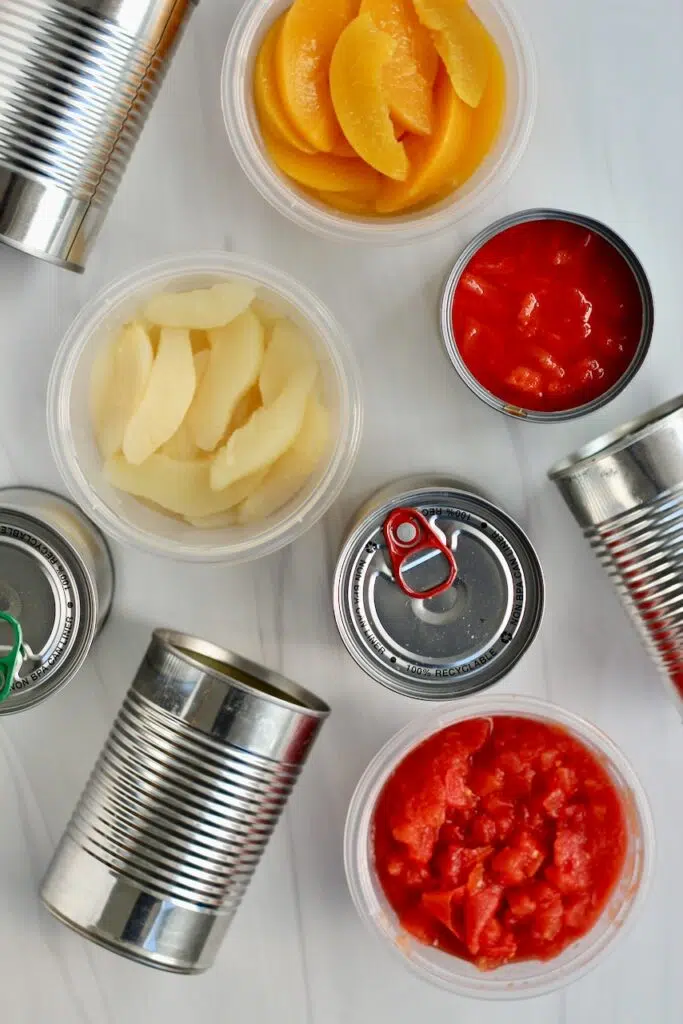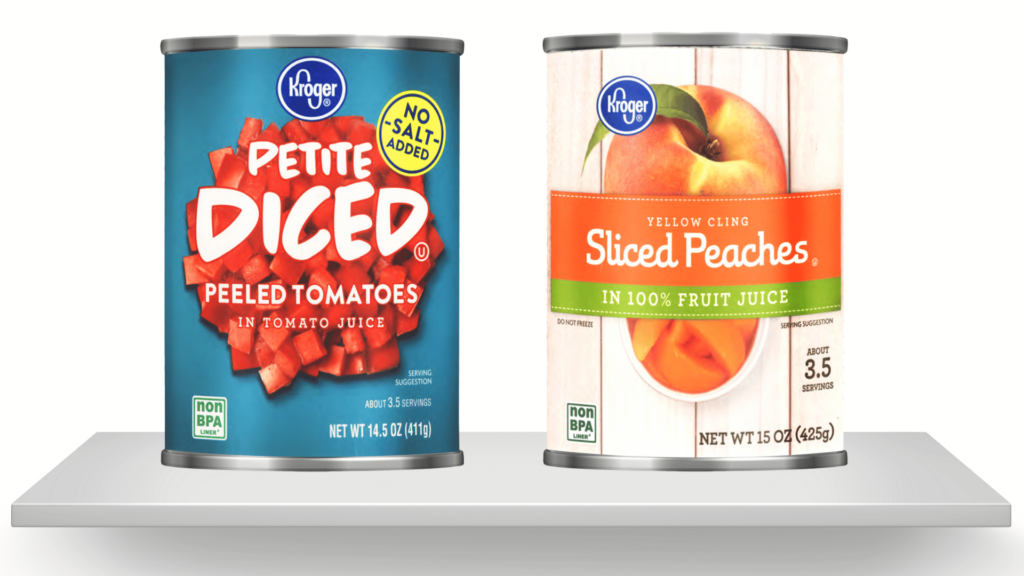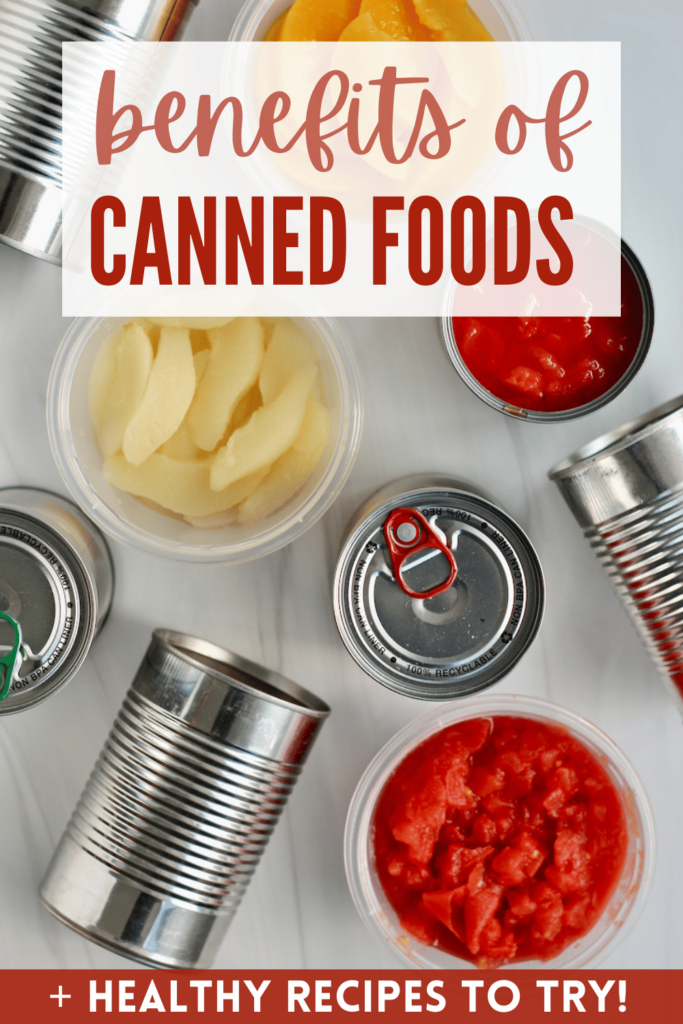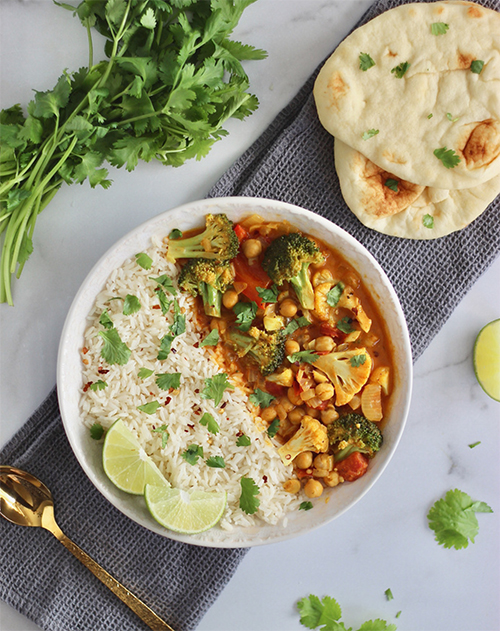Learn more about the advantages of using canned fruits and vegetables in your kitchen. Including a comparison of nutrients, health benefits, and sustainability impacts. Plus, delicious recipes to try! Just in time for National Canned Food Month!

Disclosure: This post has been sponsored by Pacific Coast Producers. All opinions are my own; I never feature a brand that I don’t love!
How are canned foods made?
Americans consume around 5 to 6 cans of fruits and vegetables each week. But how are these cans produced? Let’s talk about the journey from field to can…
- It all starts with local farmers nurturing the land to create the delicious fruits and vegetables we know and love like peaches, tomatoes, pears, greens beans, corn, and more. Did you know that there are over 2 million farmers in the U.S.?
- Next, the produce is picked, washed, and prepped by thousands of hard-working men and women. Depending on the item, it may be diced, pitted, or blanched before canning.
- Then, the cans are typically filled with water, fruit juice, or syrup before they are sealed.
- Finally, the cans are heated to a certain temperature for a prolonged period of time to ensure it kills off any harmful bacteria. This step is what allows canned foods to be shelf stable rather than refrigerated like most fresh produce.

What are the advantages of canned foods?
There are a number of benefits that come with eating canned fruits and vegetables. Canned foods are affordable, nutritious, delicious, and easy to use! This isn’t to say we should eliminate fresh produce from our diet, but rather introduce a balance of all types of produce including fresh, frozen, and canned!
1. Canned foods are budget friendly
If you’re looking for a lower cost produce option, canned goods should be your go-to! The fresh produce section can feel overwhelming with prices reaching over $6 per item. However, their canned counterparts are almost always more affordable with prices up to 20% percent less than the cost of fresh. Let’s compare a few:
- Three fresh peaches (~15 ounces) averages $3.57 vs 15 ounce can peaches averages $1.76
- Two large tomatoes (~14.5 ounces) averages $1.18 vs 14.5 ounce can tomatoes averages $0.74
- Two large pears (~15 ounce) averages $2.20 vs 15 ounce can pears averages $1.16

2. Canned foods are convenient
We know that 9 out of 10 Americans are not eating enough fruits and vegetables. And in this busy world, it can be hard to find the time to prep and cook fresh fruits and vegetables. That’s where canned goods really shine!
They are a convenient, ready-to-go option that’s available year round. Plus, they are a simple solution for meeting the recommended 5 to 9 servings of fruits and vegetables per day.
p.s. If you’re a busy professional needing more hands-on help with cooking, check out my “Coaching + Cooking” program.
3. Canned fruits and veggies are just as nutritious as fresh or frozen
Did you know canned fruits and vegetables are typically canned within hours of picking? This process locks in all of those beneficial vitamins and minerals like calcium, vitamin D, and vitamin C.
For this reason, canned fruits and vegetables have the same or higher amounts of nutrients as fresh or frozen produce.
In the case of canned tomatoes, they actually have a higher amount of lycopene and beta-carotene than fresh! This is due to the heating process of canning which increases the levels of these anti-inflammatory nutrients. In fact, 1 cup of canned tomatoes has 6641 mcg of lycopene compared to 4630 mcg in 1 cup of fresh tomatoes. Pretty cool, right?
4. Canned fruits and vegetables have health benefits
Studies have shown those who regularly eat canned foods have overall healthier eating habits. We also know eating more fruits and vegetables helps lower the risk for certain diseases like heart disease, high blood pressure, and cancer.
As a dietitian, I always recommend choosing options like no salt added canned vegetables and fruit canned in it’s own juice rather than syrup. This allows you to slash the excess sodium and added sugars.

5. Canned foods are sustainable
Canned foods typically last in the pantry anywhere from 1 to 5 years after processing! This is a much longer window than the typical 3-7 days for fresh produce. This long shelf-life can help reduce food waste which is so important for the sustainability of our planet. Plus, it means you’ll always have fruits and vegetables on hand.
When I want to throw together an easy meal without going to the store, I love relying on canned fruits and vegetables. For example, it’s so easy to whip up a veggie fried rice, fruit salad, or 5-ingredient pasta with canned goods.
Canned foods also use less energy on its journey from field to can. Plus, they don’t require additional refrigeration with transportation or storage.
Finally, don’t forget that canned foods are recyclable. This helps reduce greenhouse gas emissions which are created from landfills. Simply rinse out the can before adding to your recycling bin. These cans are made of metal which can be recycled forever without loss of quality!

How to use canned fruits and veggies
Now that you’re aware of all the advantages of canned fruits and vegetables, here’s your action step! Add 1 canned fruit or vegetable to your shopping list.
You can enjoy canned fruits and vegetables straight out of the can or incorporate it into a delicious recipe. Here’s some inspiration to get you started:
- Add diced tomatoes to one pot tomato basil pasta
- Add canned peaches into homemade salsa
- Make your own bruschetta board
- Add canned fruit cocktail into a chicken salad
- Make a power bowl with quinoa, drained canned green beans, cooked chicken, and pesto sauce
- Make 2-ingredient chia seed jam with canned fruit
- Add canned tomatoes to a bean curry
- Add canned pears to spiced scuffins
- Freeze canned fruit and add to a morning smoothie bowl

Did this blog post inspire you to use canned foods in your kitchen? I’d love to see. Tag @cheerfulchoices and @pacificcoastproducers1971 – and show us what you’re cooking!
Save this advantages of canned foods guide on pinterest:






![RECIPE below! 🍠 Sweet potato smoothie bowl! [#sponsored]
INGREDIENTS:
• 1 Bako Single Sweet Potato (steamed then cut into cubes & frozen)
• 1/2 frozen banana
• 1/4 to 1/2 cup unsweetened almond milk (depending on blender used)
• 1/4 cup plain greek yogurt
• 1 scoop chocolate protein powder
• 1 Tbsp almond butter
• 1/2 tsp vanilla extract
• 1/2 tsp ground cinnamon
Blend all ingredients until smooth (scraping down in between if needed). Then top with chocolate chips, toasted sliced almonds, cocoa nibs, and berries.
I love sweet potatoes because they’re filled with fiber, potassium, and beta-carotene… which is an antioxidant that’s important for healthy skin and vision!
#partner #bakosweet #sweetpotatoes #smoothiebowl #dietitiansofig](https://cheerfulchoices.com/wp-content/plugins/instagram-feed/img/placeholder.png)


This was beautiful Admin. Thank you for your reflections.